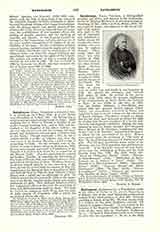

Ratramnus (RATHRAMNUS), a Benedictine monk at the Abbey of Corbie, in the present Department of Somme; one of the most important ecclesiastical authors of the ninth century, d. after 868. Scarcely anything is known of his life. His best known work is a treatise on the Holy Eucharist, entitled “De corpore et sanguine Domini”. It was written at the instance of the Emperor Charles the Bald, against a work of the same title by Paschasius Radbertus (q.v.). The basis of Ratramnus’s work is an attempt to solve the two questions: 1. Do we in the Holy Eucharist directly see the Body of Christ with our bodily eyes, or is the Body of Christ hidden from our sensory vision? 2. Is the Eucharistic Christ identical with the historic Christ? In the solution of the first question Ratramnus distinguishes correctly between the invisible substance, “invisibilis substantia”, which, he says, is truly the body and blood of Christ, “vere corpus et sanguis Christi” (xlix), and the external appearances which after the consecration by the priest remain the same as they were before (ix-x). The second question he answers in the negative, stating that the Eucharistic Christ is not in everything identical with the historic Christ “who was born of Mary, suffered, died, was buried, ascended into heaven and sitteth at the right hand of the Father” (cap. lxxxix). The work had almost been forgotten during the Middle Ages. Attention was again called to it by Blessed John Fisher, Bishop of Rochester, who cited it in defense of the Catholic doctrine on the Eucharist in the preface to his work: “De veritate corporis et sanguinis Christi in Eucharistia adversus Joh. Oecolampadium” (Cologne, 1527). It was first printed with the wrong title: “Bertrami presbyteri ad Carolum Magnum Imperatorem” (Cologne, 1532). A wrong interpretation of the words “figura” and “veritas”, and a few ambiguous passages have given rise to the opinion among a few Catholics and most Protestants that Ratramnus taught a merely symbolic presence of Christ in the Eucharist. Various German, French, and English translations made by the Sacramentarians only served to corroborate this opinion. For this reason it was placed on the Index of Prohibited Books in 1559, but was removed in 1900. His best work, from a literary as well as a dogmatic standpoint, is “Contra Graecorum opposita Romanam ecclesiam infamantium, libri quattuor”. It was written in 868 at the request of the bishops of the province of Reims, as a refutation of Photius who, in a letter to the King of Bulgaria, had fiercely assailed the “Filioque“, the papal primacy, and various customs of the Latin Church. His earliest work, “De eo quod Christus ex virgine natus est fiber”, defends the Catholic doctrine that the birth of Christ occurred in a natural manner. In his work: “De praedestinatione, libri duo”, he upholds the double predestination for salvation and damnation but not for sin. A treatise in defense of the expression “trina Deitas”, against Hincmar, has been lost, and two dissertations “De anima” are still unprinted. His works are in “P.L.”, CXXI, 1-346 and 1153-6, his extant letters in “Mon. Germ. Epist.”, VI, 149 sq.
MICHAEL OTT

